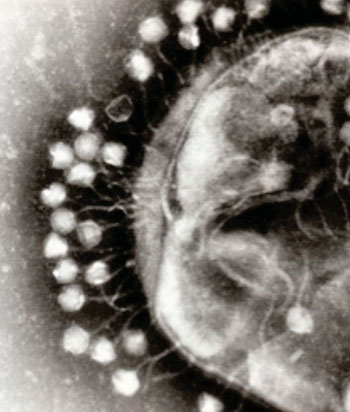Novel Phage Treatment Restores Bacterial Sensitivity to Antibiotics
By LabMedica International staff writers
Posted on 16 Jun 2015
A novel phage-based genetic strategy has been developed that aims to sensitize bacteria to antibiotics while selectively killing antibiotic-resistant strains. Posted on 16 Jun 2015
Antibiotic resistance of pathogens is a growing concern to human health, reviving interest in therapy based on anti-bacterial phage viruses. This therapy uses phages (natural bacterial enemies) to kill pathogens. However, it encounters many obstacles such as delivery barriers into tissues and bacterial resistance to phages.

Image: Electron micrograph of bacteriophages attached to a bacterial cell. Phages were used to deliver programmable DNA nuclease to reverse antibiotic resistance and eliminate the transfer of resistance between strains (Photo courtesy of Wikimedia Commons).
Investigators at Tel Aviv University (Israel) recently described a novel approach based on the use of phages to deliver a programmable DNA nuclease CRISPR–CRISPR-associated (Cas), to reverse antibiotic resistance and eliminate the transfer of resistance between strains.
CRISPRs (clustered regularly interspaced short palindromic repeats) are segments of prokaryotic DNA containing short repetitions of base sequences. Each repetition is followed by short segments of "spacer DNA" from previous exposures to a bacterial virus or plasmid. CRISPRs are found in approximately 40% of sequenced bacteria genomes and 90% of sequenced archaea. CRISPRs are often associated with cas genes that code for proteins related to CRISPRs. The CRISPR/Cas complex comprises a prokaryotic immune system that confers resistance to foreign genetic elements such as plasmids and phages and provides a form of acquired immunity. Since 2013, the CRISPR/Cas system has been used in research for gene editing (adding, disrupting, or changing the sequence of specific genes) and gene regulation. By delivering the Cas9 protein and appropriate guide RNAs into a cell, the organism's genome can be cut at any desired location.
The investigators reported in the May 18, 2015, online edition of the journal Proceedings of the National Academy of Sciences of the United States of America (PNAS) that the delivered CRISPR-Cas system destroyed both antibiotic resistance-conferring plasmids and genetically modified lytic phages. This linkage between antibiotic sensitization and protection from lytic phages was a key feature of the strategy. It allowed programming of lytic phages to kill only antibiotic-resistant bacteria while protecting antibiotic-sensitized bacteria. The strategy could reduce the prevalence of antibiotic-resistant bacteria on treated surfaces and on skin of medical personnel by using phages in a unique way that overcomes many of the hurdles encountered by phage therapy.
"We managed to devise a way to restore antibiotic sensitivity to drug-resistant bacteria, and also prevent the transfer of genes that create that resistance among bacteria," said Dr. Udi Qimron, professor of clinical microbiology and immunology at Tel Aviv University. "Antibiotic-resistant pathogens constitute an increasing threat because antibiotics are designed to select resistant pathogens over sensitive ones. The injected DNA does two things: It eliminates the genes that cause resistance to antibiotics, and it confers protection against lethal phages."
"Since there are only a few pathogens in hospitals that cause most of the antibiotic-resistance infections, we wish to specifically design appropriate sensitization treatments for each one of them," said Dr. Qimron. "We will have to choose suitable combinations of DNA-delivering phages that would deliver the DNA into pathogens, and the suitable combination of ‘killing’ phages that could select the re-sensitized pathogens. We believe that this strategy, in addition to disinfection, could significantly render infections once again treatable by antibiotics."
Related Links:
Tel Aviv University









 assay.jpg)



